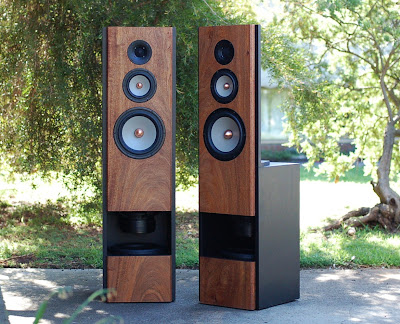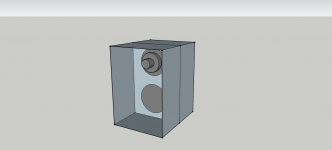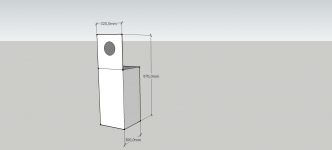I am venturing in to DIY and I am building a hybrid-open baffle solution. I have begun looking at different solutions to get good bass without making the construction to intrusive. WAF and so on.
My first idea was to build an H-frame with dual 10" long throw woofers per speaker, mounted push/pull. There is little info to find on basics of H-frames, but have I gotten things right:
- The height and width of the frame needn't be more than to fit the drivers. It is the depth that matters.
- The depth should be more than the size of the drivers?
- The deeper the frame the higher up in frequency will the peak occur?
Help is greatly appreciated. I am using miniDSP to x-over and EQ so I can tune the system a great deal.
My first idea was to build an H-frame with dual 10" long throw woofers per speaker, mounted push/pull. There is little info to find on basics of H-frames, but have I gotten things right:
- The height and width of the frame needn't be more than to fit the drivers. It is the depth that matters.
- The depth should be more than the size of the drivers?
- The deeper the frame the higher up in frequency will the peak occur?
Help is greatly appreciated. I am using miniDSP to x-over and EQ so I can tune the system a great deal.
Last edited:
I am venturing in to DIY and I am building a hybrid-open baffle solution. I have begun looking at different solutions to get good bass without making the construction to intrusive. WAF and so on.
My first idea was to build an H-frame with dual 10" long throw woofers per speaker, mounted push/pull. There is little info to find on basics of H-frames, but have I gotten things right:
- The height and width of the frame needn't be more than to fit the drivers. It is the depth that matters.
As I understand it, pretty much so
- The depth should be more than the size of the drivers?
The depth should be no more than one quarter-wavelength at the highest frequency the H-frame woofer is meant to play
- The deeper the frame the higher up in frequency will the peak occur?
The deeper the frame, the lower the frequency will occur.
Help is greatly appreciated. I am using miniDSP to x-over and EQ so I can tune the system a great deal.
A few pointers in bold.
IG
A few pointers in bold.
IG
Ok, and that is total depth, both front and back of drivers?
So If I made it 30 cm deep that would make the resonance occur at (330/0,3)/4? Have I understood it correctly? (275 hz)?
Also, how do I determine the width of the baffle up top, or the height?
I looked at some excel sheets but it was like greek to me (not your native greek-person just to be clear)
I am using a single fullrange driver, 6".
Something like this, I didn't bother to draw the bass section exact. It should be as small as possible, just so that it fits the drivers?
Attachments
Hi,
For the bass section the bigger it it the better.
For the drivers the bigger they are the better.
Unlike boxes where bigger drivers usually mean
bigger boxes there is no such constraint on OB's.
Consequently for compact OB's the biggest
driver possible is used, one that just fits.
However take a 10" design. They would work
better in a bigger design but there you can
use a 12" instead so you might as well.
Quarter Wavelength Loudspeaker Design
Linkwitz Lab - Loudspeaker Design
Music and Design
rgds, sreten.
For the bass section the bigger it it the better.
For the drivers the bigger they are the better.
Unlike boxes where bigger drivers usually mean
bigger boxes there is no such constraint on OB's.
Consequently for compact OB's the biggest
driver possible is used, one that just fits.
However take a 10" design. They would work
better in a bigger design but there you can
use a 12" instead so you might as well.
Quarter Wavelength Loudspeaker Design
Linkwitz Lab - Loudspeaker Design
Music and Design
rgds, sreten.
Wow, unless you are building an established design, an OB is a heck of a hard way to start as a newbie. It is about as complicated as I can think of. You are worried about the H-frame, how about the diffraction on the tweeter board? DSP is not magic. You need to start with the best mechanicals first. Then you are tackling a full range on top? You are going to need a lot more than good luck. Just wait until you find out full range drivers are not.
If you make the H frame too deep, it will develop a resonance peak at the upper end of the passband. If you make the H frame no deeper (total depth) than it is wide and high (for a single driver), you avoid a significant resonance peak.
The geometric length/depth of a H frame is different from the acoustic length. Look at MJKs description for the formula.
Rudolf
The geometric length/depth of a H frame is different from the acoustic length. Look at MJKs description for the formula.
Rudolf
I found that the path length between front and rear of an H-frame with equal width and depth is about 2.5x the width. If you build a 50x50 cm (WxD) frame, the effective path length will be about 1.25 meters, and you will get the dipole peak at approx 270 Hz. That in turn means that you can cross over as high as 300 Hz with such a frame.
If you build it bigger, the frequency points mentioned will shift downwards of course.
My recommendation is to build thr H-frame as large as you (or your wife...) can accept, and then select the largest drivers you can fit within that frame.
Here's my own madness.... 60x60x112 cm with dual 21" woofers.
If you build it bigger, the frequency points mentioned will shift downwards of course.
My recommendation is to build thr H-frame as large as you (or your wife...) can accept, and then select the largest drivers you can fit within that frame.
Here's my own madness.... 60x60x112 cm with dual 21" woofers.
An externally hosted image should be here but it was not working when we last tested it.
I found that the path length between front and rear of an H-frame with equal width and depth is about 2.5x the width. If you build a 50x50 cm (WxD) frame, the effective path length will be about 1.25 meters, and you will get the dipole peak at approx 270 Hz. That in turn means that you can cross over as high as 300 Hz with such a frame.
If you build it bigger, the frequency points mentioned will shift downwards of course.
My recommendation is to build thr H-frame as large as you (or your wife...) can accept, and then select the largest drivers you can fit within that frame.
Here's my own madness.... 60x60x112 cm with dual 21" woofers.
An externally hosted image should be here but it was not working when we last tested it.
I'm trying to have a look at the picture. I'm a member at diyAudio and am logged in. It asks me for a username/password when I click on the link. How do I become eligible to see the images?
- Status
- This old topic is closed. If you want to reopen this topic, contact a moderator using the "Report Post" button.
- Home
- Loudspeakers
- Multi-Way
- H-fram-bass - newbie-help please!


